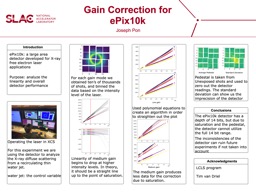/


ePix10k Joseph Pon Introduction Conclusions Acknowledgments ePix10k a large area detector developed for Xray free electron laser applications Purpose analyze the linearity and overall ID: 1012051
Download Presentation The PPT/PDF document "Gain Correction for" is the property of its rightful owner. Permission is granted to download and print the materials on this web site for personal, non-commercial use only, and to display it on your personal computer provided you do not modify the materials and that you retain all copyright notices contained in the materials. By downloading content from our website, you accept the terms of this agreement.
1. Gain Correction forePix10k Joseph PonIntroductionConclusionsAcknowledgmentsePix10k: a large area detector developed for X-rayfree electron laserapplicationsPurpose: analyze thelinearity and overall detector performanceOperating the laser in XCSFor this experiment we are using the detector to analyzethe X-ray diffuse scatteringfrom a recirculating thinwater jet.water jet: the control variableFor each gain mode we obtained ten’s of thousandsof shots, and binned thedata based on the intensitylevel of the laser.Linearity of medium gainbegins to drop at higher intensity levels. In theory,it should be a straight lineup to the point of saturation.Average PedestalStandard DeviationPedestal is taken fromUnexposed shots and used tozero out the detectorreadings. The standarddeviation can show us theimprecision of the detectorUsed polynomial equations tocreate an algorithm in orderto straighten out the plotLow gainMedium gainThe medium gain produces less data for the correctiondue to saturation. The ePix10k detector has adepth of 14 bits, but due to saturation and the pedestal,the detector cannot utilize the full 14 bit range. The inconsistencies of thedetector can ruin futureexperiments if not taken intoaccountLCLS programTim van Driel